This unusual Greek city, built on an island and preserved from the early Middle Ages, is called the “hidden city” or even the “secret city on the rock”. But there are other reasons to talk about it - for example, if you want to find out where the population of ancient Sparta went, or if you are studying the history of winemaking, and your current topic is the famous Malvasia. 
Evening view of the island and the city of Monemvasia
This city is called Monemvasia - from the Greek “one entrance” or “one approach”. It is unusual in that it is built on a small island off the eastern coast of the Peloponnese peninsula. It is believed that this rocky islet itself appeared in the mid-4th century as a result of an earthquake.
Most likely it was part of an elongated cape - traces of a large port were even found at the bottom between the island and the peninsula. At least, historians say that Monemvasia during the Byzantine period was a large - well, apparently by the standards of that time - trade and cultural center due to its location. 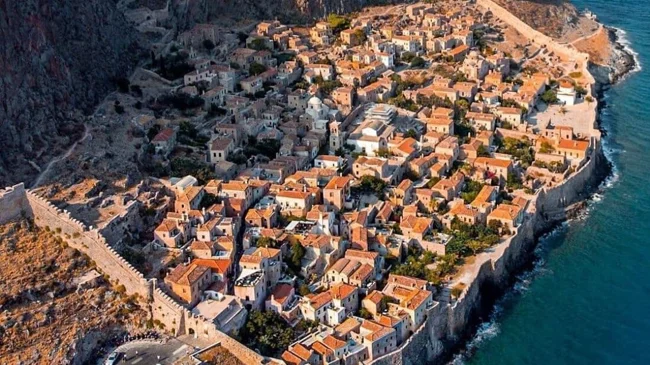
Here in one corner of the photo you can see the entrance (below), and in the other - the path to the lighthouse
The name of the city must be taken literally - the city is surrounded by a wall, in which there is only one gate for entry. An attentive reader, of course, looking at the photo above, can say that the road leads from wall to wall through the entire city and goes beyond its borders on both sides. So there are at least two entrances?
This is both true and false - the road we are talking about leads to a lighthouse standing on a steep bank. From this side it is simply impossible to land ships and climb the rocks (well, if you are not fanatical), so there is no approach to the city here. 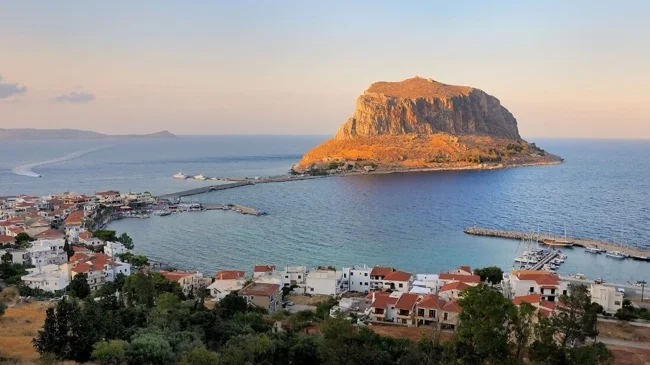
View of the island from the Peloponnese
In fact, almost the entire coastline of the island remains just as inaccessible; there is a gentle shore only on the Peloponnese side, where the path to the city begins. Of course, it was only possible to get there by ship earlier, and in the 70s of the last century a dam was built here (only about 200 meters were needed) and a road was laid - since then it has not been particularly difficult to get to Monemvasia.
But the most interesting thing is that the city itself is also not visible from here, you still have to drive along the coast along an asphalt road - and in the Middle Ages, one must think, you had to walk along the stones. 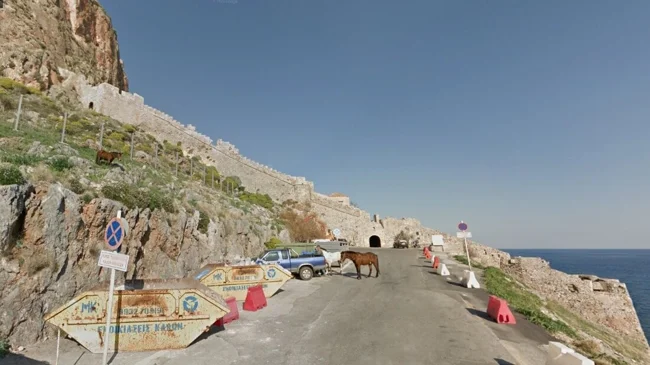
The road and wall containing the only gate to Monemvasia
Again, now there are some buildings along the road - but fifteen centuries ago, when the city was being built and growing, you had to know exactly which path to follow in order to find the entrance to the secret city. Even if you reach a wall, one end of which rests against a rock and the other goes into the sea, you still won’t understand what’s behind it—no houses or other city buildings are simply visible. An ideal strength, of course.
As you understand, the city takes up very little space on an already small island. The island itself looks like a mountain with the top cut off. The plateau, located at an altitude of about 100 meters above sea level, measures approximately 1000 by 300 meters at its widest points. 
The very only gate of Monemvasia
There are also buildings at the top - Monemvasia is conventionally divided into lower and upper towns - there you can see an ancient church, ruins of houses, steep paths fortified with stones.
Apparently, some of these buildings date back to the period of the 11th-12th centuries, when the island was almost completely populated - well, where could it be built. The church in the upper city, which is in the photo below, dates back to this period. This was the heyday of Monemvasia - at some point the city, together with the island, was called the “guardian of the western entrance to the Aegean Sea” and the “Gibraltar of the East”. 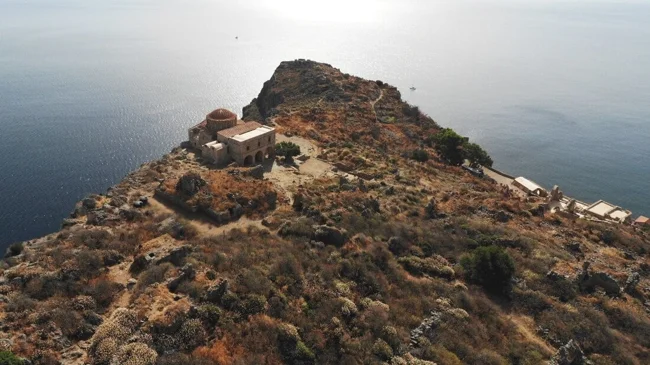
“Upper Town” – view of the old church and ruins, “Lower Town” – on the right
It is clear that they tried to capture the city more than once, but we are more interested in the earlier period, the actual settlement of the city by those who made it so important. It is believed that these are former residents of the legendary Sparta - we are, of course, talking about the so-called postclassical period. Everywhere it is emphasized that the theory is controversial, but according to some surviving chronicles, Sparta and a number of other cities of the Peloponnese were abandoned by their inhabitants at the end of the 6th century due to the invasion of the Slavs.
The inhabitants of Sparta specifically, under the leadership of their bishop, went to Monemvasia, which they used as a fortress. Despite the fact that this is only a theory, scientists argue whether the Spartans built this city or came to an already existing one. 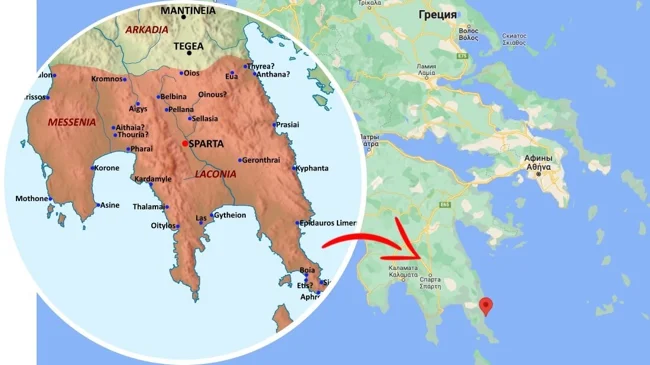
The territory occupied by Lacedaemon, also known as Ancient Sparta
But “on average” it turns out that there was a fortress here, but the entire future fate of this city in the rocks was already in the hands of its new inhabitants. If we assume that the date of its foundation is the 6th century, it still turns out to be one of the oldest fortified cities in Europe that is still inhabited. Historians highlight several significant events in the history of this fortress.
Let's say, in 1687, the fortress was defended by the Turks who fought with the Venetians. Moreover, the latter captured the entire Peloponnese, only the defenders of Monemvasia did not surrender. 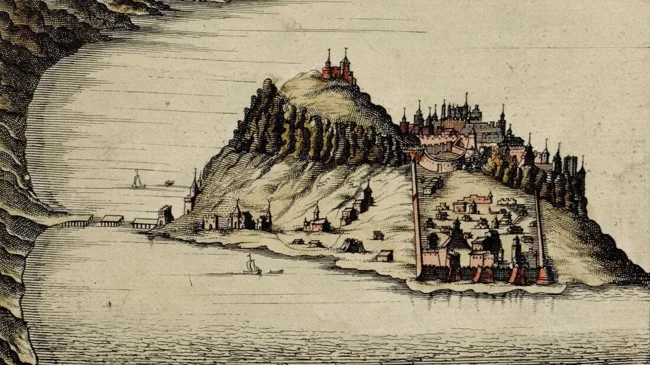
Monemvasia under Ottoman rule. Amsterdam, 1680
As a result, several sieges had to be carried out and the city fell only in August 1690. And in 1821, the War of Greek Independence began - and the Greeks besieged the city for 4 months simultaneously from land and sea, until the city was taken.
However, the future fate of the city was not too enviable. Actually, “life began” after the construction of the dam and road, at the same time numerous ancient buildings were restored, hotels were opened - in general, the tourists went. But you need to understand that by this time the city had only 72 permanent residents, water was delivered by tankers, and there was no electricity at all - it was brought to the island only in 1972, during the restoration of the city. 
View of Monemvasia from the "upper town"
It is interesting that even those who have never heard the name of the island most likely know this word, or rather, a derivative of it. It turns out that the famous wine that we call Malvasia is the same word as Monemvasia, only in the Italian manner. This is the name given to a grape variety and a type of wine made from these grapes. In wine reference books, these words are listed as synonyms - however, the emphasis in the name of the island is on the last syllable, and in the name of the wine - on the second.
According to one version, the wine received this name directly due to the fact that it was made on the island from grapes grown there. 
Malvasia grapes and Malvasia wine in barrels at a winery on the island of Monemvasia
According to another version, the name was attached due to the fact that all this wine was made, including in neighboring lands, but was taken away for sale through the port of Monemvasia.
Malvasia now, of course, refers to wines from different countries of the Mediterranean region, but in Monemvasia itself there are also craftsmen who produce wine under their own brand and lure tourists to their winery for tastings. Moreover, this experience was restored literally at the end of the last century, with the growth of tourist interest in the city - but that’s a completely different story. 
Typical promenade of a Mediterranean town in Monemvasia
0 comments
